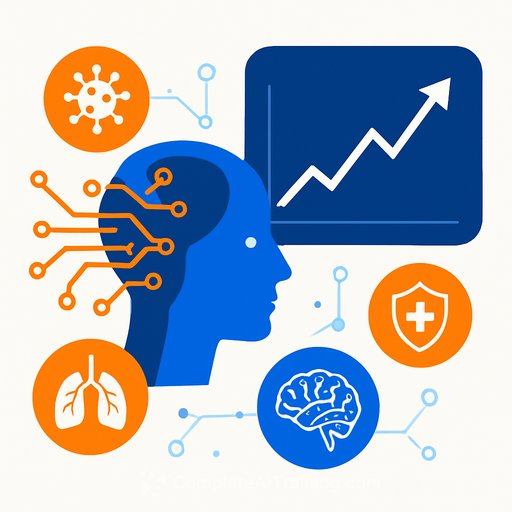AI forecasts 1,000+ diseases years in advance - what healthcare teams should know
Researchers across the UK, Denmark, Germany and Switzerland have built Delphi-2M, an AI model that predicts the rates of more than 1,000 diseases years ahead using a patient's longitudinal history. It applies transformer architecture (the same foundation used by popular chatbots) to sequences of medical events, not text.
Trained on the UK Biobank and tested on nearly two million patients in Denmark, the model identifies patterns in diagnoses and their order over time. Early results suggest stronger risk stratification for events like heart attack than age-based or single-risk calculators alone.
How it works
Think of diagnostic histories as grammar: the order and combination of past codes shape future risk. Delphi-2M learns these patterns and produces time-based probabilities across a broad panel of conditions, enabling proactive monitoring and earlier intervention strategies.
Researchers including Moritz Gerstung and Ewan Birney highlight that, unlike tools built for a single outcome, Delphi-2M estimates risk across many conditions simultaneously and over longer horizons.
What this could mean for clinical workflows
- Population health: identify high- and low-risk cohorts across cardiovascular, metabolic, oncologic and other categories from the same model output.
- Earlier action: trigger labs, imaging, or lifestyle and medication reviews sooner for patients with rising risk trajectories.
- Resource planning: align specialty referrals, screening slots, and care management capacity with predicted demand.
- Decision support: use alongside existing tools (for example, QRISK3) to cross-check risk in complex cases.
Clinical readiness and limitations
Delphi-2M is not ready for clinical use. The training and test datasets show bias in age, ethnicity, and current healthcare outcomes; performance will vary by system and population.
- Local validation: run retrospective evaluations on your EHR data before any frontline use.
- Calibration: align predicted probabilities to local incidence rates and coding practices.
- Fairness: audit subgroup performance (age, sex, ethnicity, comorbidity burden) and set thresholds accordingly.
- Explainability: prioritize features and rationale that clinicians can scrutinize; this remains an active research area noted by Gustavo Sudre and others.
- Governance: define accountability, documentation, update cadence, and guardrails for escalation.
Where it may fit first
- Retrospective risk discovery: find missed opportunities for prevention and track potential ROI.
- Panel management: flag patients for nurse-led outreach or pharmacist reviews based on multi-condition risk.
- Screening optimization: adjust frequency or modality for patients with persistent high risk across time windows.
Technical snapshot
- Model class: transformer-based neural network for sequential healthcare data.
- Inputs: longitudinal encounters and diagnoses; learns combinations and order of events.
- Outputs: time-based probabilities for 1,000+ conditions from a single model pass.
- Data: trained on the UK Biobank, tested on Denmark's national health data (~2M patients).
Practical steps for healthcare leaders
- Stand up an AI oversight group with clinical, data, ethics, and legal roles.
- Run a retrospective pilot: define targets (e.g., ACS, HF, CKD), compare to current risk tools, and quantify net benefit.
- Plan integration: surface predictions in the EHR with clear time horizons, confidence, and next-best action prompts.
- Define interventions: link thresholds to specific orders, referrals, or education-not just scores.
- Monitor drift: track calibration and alert fatigue; revalidate after guideline or coding changes.
- Communicate with patients: set expectations about predictions, uncertainty, and privacy.
Bottom line
Delphi-2M shows that multi-disease, long-horizon prediction is feasible at scale. For now, treat it as a strong signal for where clinical AI is heading: multi-condition risk, earlier intervention windows, and smarter resource allocation-provided we solve for validation, bias, and explainability.
If you're building clinical AI literacy across teams, see practical training options here: AI courses by healthcare role.
Your membership also unlocks:




